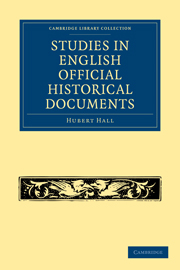Book contents
- Frontmatter
- PREFACE
- Contents
- ERRATA
- PART I THE SOURCES OF OFFICIAL HISTORICAL DOCUMENTS
- PART II THE DIPLOMATIC OF OFFICIAL HISTORICAL DOCUMENTS
- INTRODUCTION TO THE DIPLOMATIC STUDY OF OFFICIAL DOCUMENTS
- THE ANGLO-SAXON CHARTERS
- ANGLO-NORMAN CHARTERS AND WRITS
- LATER CHARTERS AND DIPLOMATIC INSTRUMENTS
- LETTERS, STATE PAPERS AND DEPARTMENTAL INSTRUMENTS
- ROYAL SURVEYS, INQUISITIONS AND ASSESSMENTS
- ROYAL ACCOUNTS
- JUDICIAL PROCEEDINGS
- APPENDIX I A Classified Table of Diplomatic Instruments
- APPENDIX II Early Diplomatic Criticism
- APPENDIX III The Charters of King Athelstan (Concordance of Formulas)
- APPENDIX IV Table showing the Relationship of the Pre-Conquest and Post-Conquest Diplomata
- APPENDIX V Documents connected with the Issue of the Great Seal (1662)
- APPENDIX VI Fees of the Seal
- APPENDIX VII Note on the Bibliography of English Diplomatic
- PART III THE PALAEOGRAPHY OF OFFICIAL DOCUMENTS
- TABLE OF MATTERS
LETTERS, STATE PAPERS AND DEPARTMENTAL INSTRUMENTS
Published online by Cambridge University Press: 07 September 2010
- Frontmatter
- PREFACE
- Contents
- ERRATA
- PART I THE SOURCES OF OFFICIAL HISTORICAL DOCUMENTS
- PART II THE DIPLOMATIC OF OFFICIAL HISTORICAL DOCUMENTS
- INTRODUCTION TO THE DIPLOMATIC STUDY OF OFFICIAL DOCUMENTS
- THE ANGLO-SAXON CHARTERS
- ANGLO-NORMAN CHARTERS AND WRITS
- LATER CHARTERS AND DIPLOMATIC INSTRUMENTS
- LETTERS, STATE PAPERS AND DEPARTMENTAL INSTRUMENTS
- ROYAL SURVEYS, INQUISITIONS AND ASSESSMENTS
- ROYAL ACCOUNTS
- JUDICIAL PROCEEDINGS
- APPENDIX I A Classified Table of Diplomatic Instruments
- APPENDIX II Early Diplomatic Criticism
- APPENDIX III The Charters of King Athelstan (Concordance of Formulas)
- APPENDIX IV Table showing the Relationship of the Pre-Conquest and Post-Conquest Diplomata
- APPENDIX V Documents connected with the Issue of the Great Seal (1662)
- APPENDIX VI Fees of the Seal
- APPENDIX VII Note on the Bibliography of English Diplomatic
- PART III THE PALAEOGRAPHY OF OFFICIAL DOCUMENTS
- TABLE OF MATTERS
Summary
Mediaeval and Modern Official Letters
In the State Papers of the 16th century, regarded as Royal Letters or official correspondence, the devolution of the mediaeval writ or letter missive can be clearly traced. Specimens of these diplomatic forms may still be found in a considerably later period, but for a long time past they have been giving place to an epistolary modification which has been evolved from the trilingual instruments in use during the greater part of the 15th century. At length, with the beginning of the 16th century, the bulk of the official correspondence hitherto associated with the practice of the royal Chancery has begun to assume a conventional and vernacular form.
An epistolary style was naturally employed in this country, as abroad, from a very early date. Its use, however, may be regarded in the light of a literary exercise rather than as a means of official communication, although we have seen that the composition of the vernacular writ was materially affected thereby, even before the Norman Conquest.
In one aspect, therefore, the private letter appears to furnish us with better examples of the epistolary style than the royal missive itself. On the other hand, we must remember that the existing series of mediaeval official letters is somewhat fragmentary and that there is no consistent use of epistolary forms until the general adoption of the vernacular style.
Whether the formulas of this vernacular letter can be derived directly from the French or Latin models of an earlier period is a somewhat obscure point.
- Type
- Chapter
- Information
- Studies in English Official Historical Documents , pp. 270 - 280Publisher: Cambridge University PressPrint publication year: 2010First published in: 1908



